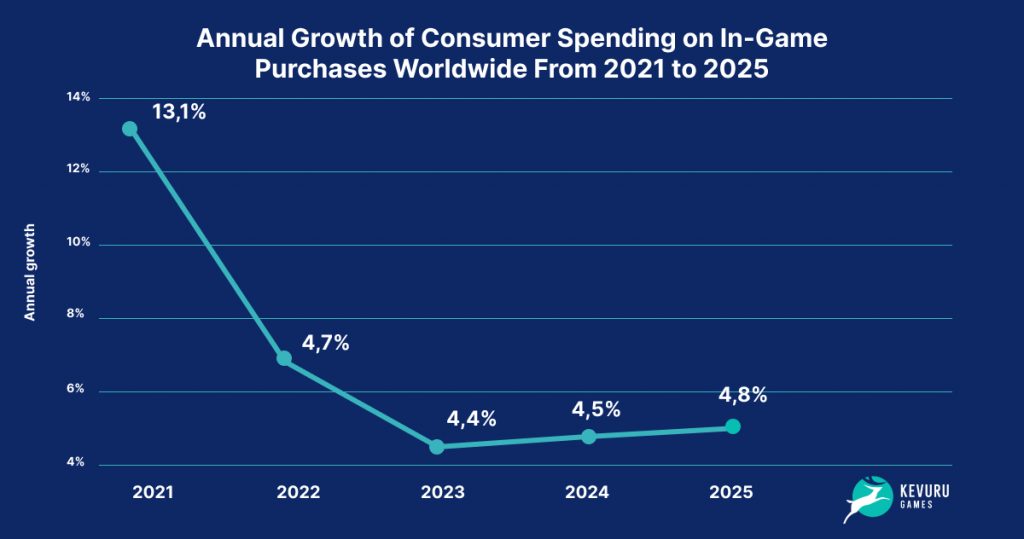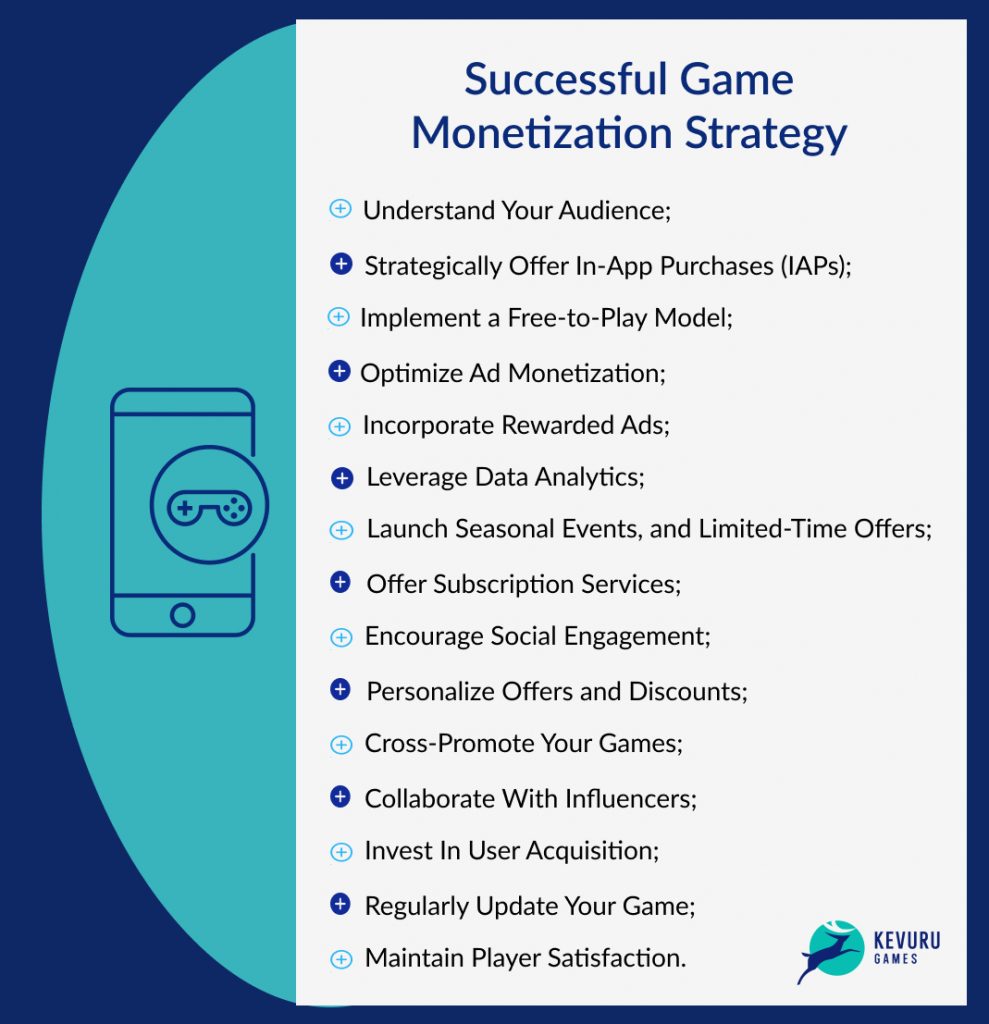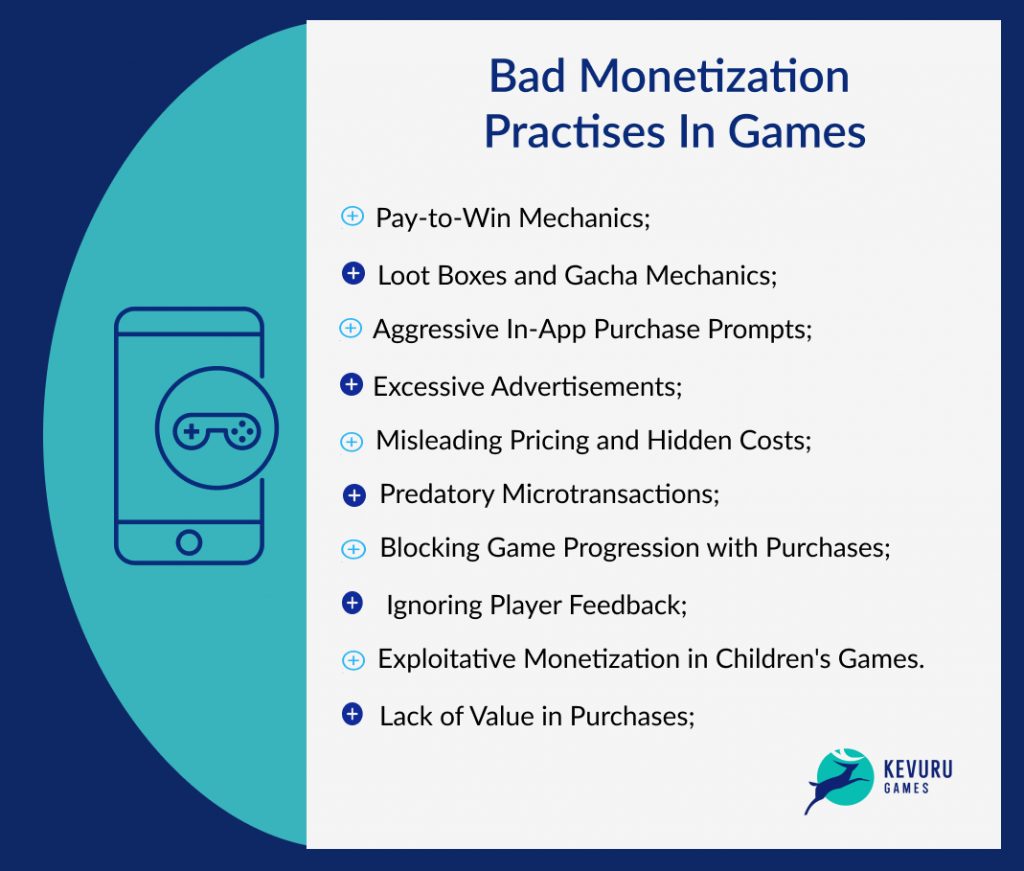Before we delve into specific strategies, we must grasp the concept of game monetization. Game monetization refers to earning revenue from games, often through in-game purchases, ads, or subscription models. It is a delicate balance that involves providing valuable content to players while encouraging them to spend on optional in-game items.
To unlock the potential of monetization, game developers must understand player psychology and motivations. By aligning monetization strategies with player preferences, developers can create a win-win situation for players and themselves.
Why Is It Important to Monetize Games?
Video gaming has transcended its niche roots to become a billion-dollar juggernaut, boasting an annual industry value of 197 billion U.S. dollars. Mobile gaming stands out among the various revenue segments, generating over $91 billion in annual revenues. So, what are the models of monetization in video games?
The gaming industry thrives on many mobile game monetization models, and no one-size-fits-all approach exists. Game developers often adopt the pay-to-download model.
1. Pay-to-Download Model (P2D):
The pay-to-download model, also known as the “premium” or “pay-to-play” model, involves players paying an upfront fee to download and access the game. In this model, developers typically set a fixed price for the game, and once players make the payment, they gain full access to all the game’s content and features. No additional in-game purchases are required to progress or enjoy the game entirely.
2. Free-to-Play (F2P) Model:
The free-to-play (F2P) model has gained immense popularity recently, particularly in mobile and online gaming. In this model, the game is free, allowing anyone to download and play without any initial cost. However, developers generate revenue by providing various in-app purchases (IAPs) or virtual goods within the game. These can include cosmetic items, power-ups, in-game currency, or other enhancements players can buy to enhance their gaming experience.
3. Pay-to-Win Model (P2D):
The pay-to-win model is a controversial monetization approach that has garnered criticism from players and gaming communities. In pay-to-win games, players can purchase in-game items, upgrades, or advantages that significantly impact gameplay, giving them a distinct advantage over those who choose not to spend money.
This model can create an imbalanced and unfair gaming environment, as players who invest money can progress faster, defeat opponents more efficiently, or access exclusive content that non-paying players can’t. Pay-to-win models are often seen as “paying for success,” frustrating players who prefer skill-based challenges and a level playing field.
Features of Mobile Game Monetization
Player engagement is the heart of successful monetization. Loyal and satisfied players are more likely to spend money on in-game purchases. Strive to create an immersive gaming experience that keeps players hooked and wanting more. Let’s explore some tried-and-tested monetization methods that can boost your game’s revenue:
1. In-App Purchases (IAP)
IAPs are a popular method of monetization where players buy virtual goods or currency within the game. Offer various IAP options, ensuring they enhance the gaming experience without being essential for progress:
- buying gems, cosmetics;
- in game currencies;
- character purchase;
- buying boosts, etc.;

2. Ad Monetization
Integrating ads into your game can provide a steady game revenue. Consider implementing rewarded ads, where players receive in-game rewards for watching ads voluntarily.
3. Subscription Model
Subscription-based monetization offers players exclusive perks and content for a recurring fee. This approach can foster long-term player loyalty and a predictable revenue stream:
- buying premium subscription game;
- pass purchase;
- VIP status purchase;
- battle passes.

4. Loot Boxes and Gacha Mechanics
Loot boxes and gacha mechanics can excite players as they anticipate valuable rewards. However, ensure these mechanics are fair and transparent to maintain player trust.

5. Limited-Time Events and Sales
Organize special in-game events or sales with exclusive rewards. Limited-time offers can create a sense of urgency, encouraging players to make purchases:
- monetized timer;
- monetized continue button;
- monetized retry button etc.
6. Offering Early Access
Providing early access to upcoming game content or features can incentivize players to support your game financially.
How To Maintain a Positive Reputation While Generating Revenue
If you want to monetize your game as a developers’ team, consider ethical practices, prioritizing player satisfaction and fairness. The following guidelines will help you maintain a positive reputation while generating revenue:
1. Transparency and Honesty
Communicate all in-app purchases and their benefits to players. Avoid any misleading information that could lead to frustration.
2. Balancing Free and Paid Content
Strike a balance between free and paid content to ensure non-paying players enjoy the game without feeling disadvantaged.
3. Avoiding Pay-to-Win Mechanics
Pay-to-win mechanics can harm the player experience and reputation of your game. Focus on creating a fair playing field for all players.
4. Respecting Privacy and Data Security
Protect players’ personal information and adhere to relevant data protection regulations.
How To Increase Mobile Game Monetization?
Increasing mobile game monetization is a crucial aspect of driving revenue and ensuring the long-term success of your game. A successful monetization strategy is a delicate balance between generating revenue and delivering an enjoyable gaming experience. We want to share with you some practical strategies on how to make a good mobile game and how to increase monetization in mobile games:
- Understand Your Audience: To optimize mobile game monetization, understand your target audience. Analyze player behavior, preferences, and spending patterns.
- Strategically Offer In-App Purchases (IAPs): Integrate enticing in-app purchases that enhance the gaming experience. Provide valuable virtual goods, power-ups, and exclusive content.
- Implement a Free-to-Play Model: Adopt a free-to-play (F2P) model to attract a broader player base. Ensure the core gameplay is engaging, allowing players to enjoy the game without immediate pressure to spend money.
- Optimize Ad Monetization: Implement ads strategically to maximize revenue without compromising the user experience. Balance ad frequency and placements, and offer players the option to remove ads through an in-app purchase.
- Incorporate Rewarded Ads: Implement rewarded ads that offer in-game rewards in exchange for watching ads. This non-intrusive approach incentivizes players to engage with ads willingly.
- Leverage Data Analytics: Utilize data analytics to track player behavior, identify spending patterns, and optimize your monetization strategies. Data-driven decisions ensure you stay agile and responsive to player needs.
- Launch Seasonal Events, and Limited-Time Offers: Create time-limited events and special offers to foster a sense of urgency and encourage players to purchase.
- Offer Subscription Services: Implement subscription-based models with exclusive benefits and rewards. Subscriptions can provide a stable revenue stream while fostering player loyalty.
- Encourage Social Engagement: Integrate social features to encourage player interaction. Players engaged with friends and communities are more likely to invest in their in-game experiences.
- Personalize Offers and Discounts: Personalization increases players’ chances to respond positively to monetization opportunities.
- Cross-Promote Your Games: Leverage your portfolio to cross-promote new releases or updates. Existing players are more likely to explore and invest in your new games.
- Collaborate with Influencers: Partner with influencers to promote your game and its monetization features. Influencer marketing can significantly increase visibility and player engagement.
- Invest in User Acquisition: Allocate resources to targeted user acquisition campaigns to attract high-value players more likely to engage with your monetization options.
- Regularly Update Your Game: Consistent updates, new content, and improvements keep players engaged and invested in the game, increasing the likelihood of monetization.
- Maintain Player Satisfaction: Prioritize player satisfaction and fairness in your monetization strategies. Avoid pay-to-win mechanics or practices that may lead to player frustration and negative feedback.

Examples of Bad Monetization in Games
Bad game monetization refers to practices prioritizing profits at the expense of player satisfaction and fairness. While game makers aim to generate revenue, some monetization strategies can lead to negative player experiences, ethical concerns, and a lack of transparency. Let’s explore some examples of bad monetization practices in games:
1. Pay-to-Win Mechanics: Games that heavily favor paying players by offering powerful in-game items, upgrades, or advantages create an unfair advantage for those who spend money. This approach undermines the skill-based nature of games and alienates non-paying players, leading to frustration and a sense of inequality.
2. Loot Boxes and Gacha Mechanics: Loot boxes and gacha mechanics involve purchasing random virtual items or characters with real money. The element of chance in obtaining desired items can lead to excessive spending, especially among vulnerable players like minors, who may develop addictive behavior.
3. Aggressive In-App Purchase Prompts: Games that constantly push players to make in-app purchases through intrusive pop-ups or aggressive prompts can create a negative user experience. Payers usually perceive it as pressuring to spend money, diminishing the game’s enjoyment.
4. Excessive Advertisements: Overloading games with frequent and lengthy advertisements disrupts gameplay and hampers the overall experience. Players may become frustrated and, as a result, abandon the game due to an excessive ad presence.
5. Misleading Pricing and Hidden Costs: Misleading pricing, hidden costs, or unclear subscription terms can misguide players into spending more than intended. This lack of transparency erodes trust between players and developers.
6. Predatory Microtransactions: Games that utilize predatory microtransactions, targeting vulnerable players or encouraging impulsive spending, can lead to financial harm and adverse psychological effects.
7. Blocking Game Progression with Purchases: Implementing artificial barriers, or “paywalls,” that obstruct players’ progress unless they make purchases can create frustration and resentment. This approach can hinder players from enjoying the game without spending money.
8. Ignoring Player Feedback: When developers ignore player feedback regarding monetization concerns or fail to address exploitative practices, it can create a perception that profits are prioritized over player satisfaction.
9. Lack of Value in Purchases: Charging high prices for in-game items or virtual currency without providing commensurate value can leave players feeling cheated and dissatisfied with their purchases.
10. Exploitative Monetization in Children’s Games: Monetization strategies that exploit children’s limited understanding of money or use manipulative techniques to encourage spending are particularly concerning and ethically problematic.
Game developers should avoid these bad game monetization practices and instead focus on ethical, player-centric approaches that prioritize fair gameplay, transparency, and a positive user experience. Developers can create sustainable and enjoyable games that thrive without intrusive monetization by building trust and respecting player preferences.

Kevuru Games Expertise in Games Monetization
Kevuru Games, a gaming company with 11 years of experience in the market as iOS game developers and Android game development services. Our mission is to provide game publishers with full-cycle game development production and give our clients player-centric advice as to strategies for in-game monetization. With these years of experience and a deep understanding of the gaming ecosystem, we know how to make the game to get the best out of monetization in the post-production stage.
All in all, we offer a full range of mobile game development services, including:
Fully executed development;
Concept art and design;
Quality assurance and testing;
Game monetization or ads in video games;
Localization of the game;
Post-release support.
Game monetization is not a one-size-fits-all approach; it requires careful analysis of gaming metrics and tailored strategies for each project. At Kevuru Games, we take a customized approach in advising on how to monetize each game, knowing each has its own identity and audience. We advise you to make thorough research, data analysis, and market trend evaluation to ensure our monetization plan perfectly suits your game’s audience and niche.
One of the key aspects of successful game monetization is the integration of non-intrusive and engaging video games or in app advertising formats. Our team is adept at implementing innovative ad formats seamlessly integrating with the gaming experience.
It’s always better to analyze user behavior, dwell time, and revenue metrics to gain invaluable insights into your game’s performance. These insights allow us to regularly refine our strategies and ensure that your game stays ahead of the competition and generates significant revenue.
Whether your video game falls into the action, puzzle, simulation, or RPG genre, whether it’s a mobile game, mobile apps or multiplayer games we will help you develop the perfect monetization strategy. As different game genres require different approaches.
The gaming industry is constantly evolving, and so are the trends in monetization. At Kevuru Games, we monitor the trends in the industry and adjust our strategies accordingly.
Summary
Successful game monetization requires a deep understanding of player behavior, ethical practices, app game development cost and a customized approach for each game. By prioritizing player satisfaction and delivering engaging experiences, developers can create profitable games while building a positive reputation in the gaming industry.











